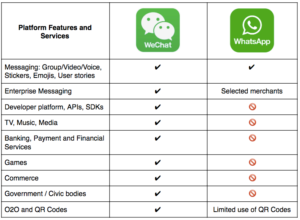A lot has happened since I blogged a long-form. This year’s resolution is to write more than just a short stream of 140 characters.
A lot has happened since I blogged a long-form. This year’s resolution is to write more than just a short stream of 140 characters.
I am excited to share that I am joining Chargebee to help accelerate the company’s Growth in its subscription management and billing product. Look forward to working with the team and founders of Chargebee: Krish, Rajaraman, Thiyagu, and KPS.
Read more at https://medium.com/@1ndus/i-am-joining-chargebee-d5485d63fb92
Recorded an introductory video about the dense topic of Smart Decision Making. This is based on my earlier talk at Haas School of Business, UCB.
 I believe WhatsApp can do more. It has become a utility, but failing at showing the full potential of a communication medium to its installed base, especially in India.
I believe WhatsApp can do more. It has become a utility, but failing at showing the full potential of a communication medium to its installed base, especially in India.
You can read the full post at https://medium.com/pen-bold-kiln-press/is-whatsapp-stifling-the-art-of-the-possible-in-india-ae0924fc7741
Wrote this on my blog at Medium.
There is plenty of advice online on creating and presenting a startup pitch deck. They range from:
Read the full post at https://medium.com/@1ndus/5-pro-tips-for-presenting-your-startup-pitch-deck-23bd42e87926
Slides from a talk I gave about decision making earlier this month at UC Berkeley.

External scorecard and customer satisfaction score calculation have become common, especially amongst SaaS vendors, whereas, there are very few techniques of arriving at an internal scorecard of a product.
The full post at https://medium.com/@1ndus/internal-scorecard-of-a-product-6382e1ae0597
Jerry Chen of Greylock wrote a fantastic piece on moats. He gave a refresher on traditional defensible moats used by technology companies (sustained by scale and network effects) and introduced the Systems of Intelligence (SOI) as a new defensible moat within the enterprise stack. The SOI is sandwiched between the Systems of Engagement (web, chat, mobile) at the top and the System of Record (CRM, HCM, ERP, ITSM) at the bottom.
A system of intelligence aggregates, analyzes, and acts on data passing through it–reduces human intervention, and takes decisions on their collective behalf. Extending Jerry’s thought, a defensible moat is not just AI; it is automated custom actions, stellar visualizations, and an engine to accelerate the system itself.
Let’s imagine what a System of Intelligence would mean in the world of enterprise cloud SaaS products. Today, when you want to buy best-of-breed cloud products you buy a vertical SaaS. But even though most vertical SaaS products supplanted many individual “modules” in the vintage single instance and single vendor on premise software stack, they remain highly specific and fragmented.
For example, there’s a SaaS product for sending mass marketing e-mails to consumers, sending out post-purchase surveys, or engaging users on a site. There are a half-a-dozen products one has to use to analyze a customer workflow (or touchpoint) across channels. At each stage of the workflow, data is generated and then stitched to get a state transition value.
In enterprise SaaS, the System of Intelligence is an analytics mesh, which coalesces many individual data-points and provides actionable insights. This gives birth to a new kind of defensible moat because the vertical SaaS is now serving as data sensors that are tightly coupled with the enterprise user on every device.
BI and analytics products such as Tableau, Domo, Qlik and other tools are precursor to tomorrow’s Systems of Intelligence. Today, they do a good job in providing a unified data aggregation and analytics layer on top of customer, employee, and prospect workflows.
We will continue to see disintermediation of general purpose analytics products, and domain-specific intelligence tools will win over generic aggregation. AI will help stitch the data together and create automatic actions, which is when intelligence will drive system acceleration.
Some SaaS ventures lead to category leadership while some lead to imaginary frozen quadrants. Here’s a little 2X2 to assess where you are in your journey to SaaS nirvana. When amazing products are sold in amazing ways, it produces the almost mystical flywheel effect.
Let’s dissect this.
Red: Weak Product and a Weak/Average Sales Team
This is a highly incremental quadrant where a single provider may be serving the exact needs of a handful of customers. It’s an equilibrium that doesn’t last too long. I’ll leave this quadrant at that.
Blue: Weak Product and a Strong Sales Team
When people say “that company is sales driven” this is what they are referring to. Founders of companies in this quadrant have a knack of story-telling and projecting a product market fit before a product is actually ready. What happens next is catastrophic. Sales drives the company’s culture, narrative, and product building. Both product and engineering go into a wild-balancing act of fixing the problems while trying to add features in a near random fashion.
It is unsustainable. It bloats customer service, support, and pre-sales. Lack of a strong product causes politicking, confusion, and populism in every department, which leads to relationship-driven rather than value-proposition driven outcomes. Unless a startup iterates on product rapidly or brings in a disciplined and creative leader, there’s a significant risk of revenues plateauing at $5m-$10m mark.
So why is it blue? Because it is fairly cushioned for a while though sales > everything is bad karma.
Yellow: Strong Product and a Weak/Average Sales Team
This quadrant probably causes hackers amongst us the most heartburn. A lot of strong products start with nobody focused on sales. They continue to write amazing code, design amazing screens, and setup amazing data pipelines, but they just don’t know how to position, craft a story people remember, distinguish themselves from 99 other guys who may have had the same idea. Many product founders suck at sales and often hire the first person who blinks.
Even for successful startups, this can be a transient stage, but successful founders realize their mistakes and then quickly hire a sales leader and move to the next quadrant. The good news if you’re yellow is that just like in real life, you can cross the traffic light before too much damage happens.
Green: Strong Product and Strong Sales Team
This is jazz improvisation zone. You can have a strong product and sales culture. It all starts with respect for both and it certainly involves finding the right talent that can craft what really works uniquely for you.
That’s why very few founders get there. A scalable sales model is crucial. A product alone can take you so far. For every Dheeraj Pandey ringing the IPO bell, there’s a Sudheesh Nair driving the quota home. For every Jyoti Bansal getting acquired at $3.7bn, there’s a Dali Rajic digging into sales capacity, and for every Jason Lemkin, there’s a Brendon Cassidy. When phenomenal founders and product builders pair up with their sales counterparts, to accomplish a sight to behold – a startup on a flywheel across the sky.
In each of these cases, the sales counterparts were able to hit their targets, because of a product which was able to either create demand or was superior to incumbents. If there was a product market fit, based on the narrative, the product scaled to bring in a perpetual stream of renewals and sources of new revenue.
Hopping in the 2×2
I hope you’ve found your color by this point. So how do we transition from a shitty part of the quadrant to an awesome one?
If you are Blue or Yellow, scale to Green quick. Here are some things that increase your chances in a hop
Good luck and let me know if you think of additional colors.
Thanks to Leena for flywheeling this post!
It’s been almost 4 months at SirionLabs. I started as a Chief Marketing Officer, to drive a data-driven marketing culture. Within a month, I started working on activities which were ancillary to what a marketer is supposed to do—soon my R&R got expanded (more on this, in future).
My immediate challenge was how do I get acquainted myself to a large cross-functional team. I don’t like sending e-mails to a large distribution saying, “Meet your new boss”. Being on the other side of the table, I always hated those e-mails coming from someone who was many hops away.
A better idea was I thought, why not simply organize 1-on-1 meetings.
The big question was how do I get them excited to talk, get them engaged with me, still have a formal communication, but break-the-ice right away.
In the past, I had mixed success with 1-on-1s with large teams–they were a hit or miss. When my former bosses did 1-on-1s with me I always thought, “Is he even listening to me?”, “Does he even know what I’m working on?”.
I did not want my extended team think about me the same way. Plus, I wanted to deep dive into their inner-workings, what they do, what excites them, what demotivates them, etc. etc. The theory was that if the discussion started within the context of their day-to-day work, the answers would be easily found. I hypothesized.
A better way to do 1-on-1 is to start with a demo, get the team member present what they are working on, present an idea, and then do the formal 1-on-1.
Here’s a screen grab of the agenda of many such 1-on-1s I did last week, this week and many more to go the next week.
I’m going to continue to use this format in future. I found it engaging and made both the parties to open up quickly and start at a common ground.
PS> It’s a different topic altogether that the 1-on-1s are not an easy feat by itself when you have dozens of people who are 13 and half timezones away!